|
Here are some more of the sights and the personalities of Chicago '86.

There was a great deal of cross-membership between the Windy City Veterans Association and the Chicago Police. A lot of the
veterans who were looking after us were Chicago cops. Plenty were firemen too. Here Robert Dodds and Barry Dowsett are about
to go out on patrol in a Chicago Police car.
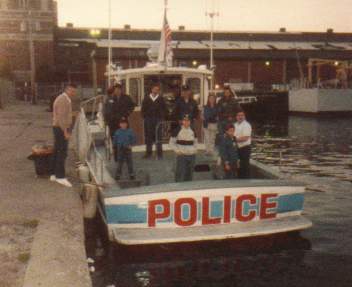
Here the Chicago Police are about to take us out on Lake Michigan on a patrol boat.
That's me in the middle, Peter Poulton on the right, Brian Wizard behind him, and Barry Dowsett about to step on board. The
picture is too dark to recognise anybody else.

Chicago by night, as seen from the Police patrol boat.
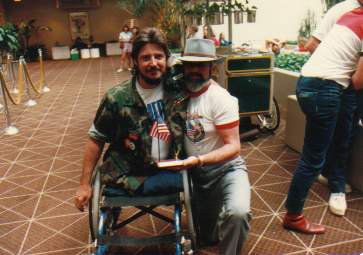
As fine a pair of blokes as you'd ever want to meet. American veteran Jim Logsden, from Indiana, with John Wilson. Jim came
to Australia in 1987 and marched in the Australian Welcome Home Parade. Sadly, John died only a few weeks before the Sydney
parade.
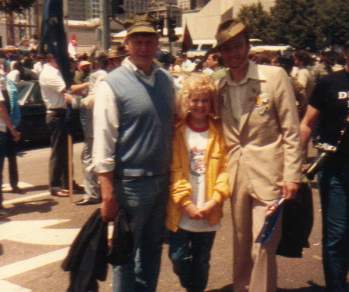
With me in this picture, despite the shadows on our faces, is Rick Eilert with his
daughter. Rick is the author of "For Self and Country", and was an active member of the Illinois Vietnam Veterans Leadership
Program.
Our friends in Chicago arranged for us to fly to Washington DC to visit "The Wall", the Vietnam Veterans Memorial.
In the next two pictures, Bob Gibson is leaving his slouch hat and a small Australian flag at The Wall. In my poetry pages
you will find a sonnet which gives some indication of how moving this place is. The poem is called "The Wall - An Australian
View".
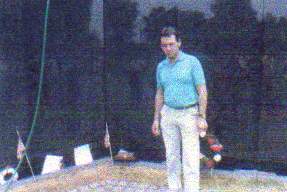
Click on either of these pictures to check out the "Virtual Wall" website.

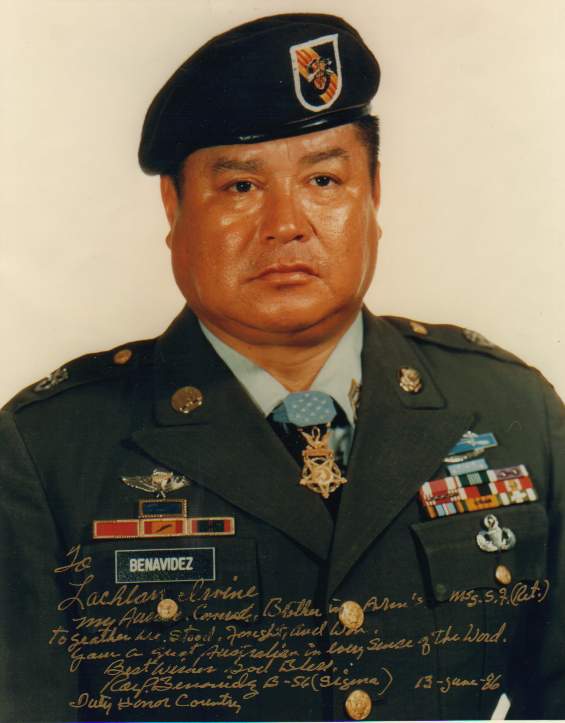
Congressional Medal of Honor winner, the late Roy P Benavidez. If you want to know what it takes to be called a hero, just
read on. This is an extract from Roy's Medal of Honor citation. I'll take it from the point at which Roy sees helicopters
returning to his base to unload wounded Special Forces soldiers after a heavy contact. "Sergeant Benavidez voluntarily
boarded a returning aircraft to assist in another extraction attempt. Realizing that all the team members were either dead
or wounded and unable to move to the pickup zone, he directed the aircraft to a nearby clearing where he jumped from the hovering
helicopter, and ran approximately 75 meters under withering small arms fire to the crippled team. Prior to reaching the team's
position, he was wounded in his right leg, face and head. Despite these painful injuries, he took charge, repositioning the
team members and directing their fire to facilitate the landing of an extraction aircraft, and the loading of wounded and
dead team members. He then threw smoke cannisters to direct the aircraft to the team's position. Despite his severe wounds
and under intense enemy fire, he carried and dragged half of the wounded team members to the awaiting aircraft. He then provided
protective fire by running alongside the aircraft as it moved to pick up the remaining team members. As the enemy's fire intensified,
he hurried to recover the body and the classified documents of the dead team leader. When he reached the team leader's body,
Sergeant Benavidez was severely wounded by small arms fire in the abdomen and grenade fragments in his back. At nearly the
same moment, the aircraft pilot was mortally wounded, and his helicopter crashed. Although in extremely critical condition
due to his multiple wounds, Sergeant Benavidez secured the classified documents and made his way back to the the wreckage,
where he aided the wounded out of the overturned aircraft, and gathered the stunned survivors into a defensive perimeter.
Under increasing enemy automatic weapons and grenade fire, he moved around the perimeter distributing water and ammunition
to his weary men, reinstilling in them a will to live and fight. Facing a buid-up of enemy opposition with a beleaguered team,
Sergeant Benavidez mustered his strength, and began calling in tactical air strikes and directing the fire from supporting
gunships, to suppress the enemy's fire and so permit another extraction attempt. He was wounded again in his thigh by small
arms fire whilst administering first aid to a wounded team member just before another extraction helicopter was able to land.
His indomitable spirit kept him going as he began to ferry his comrades to the craft. On his second trip with the wounded,
he was clubbed from behind by an enemy soldier. In the ensuing hand-to-hand combat, he sustained additional wounds to his
head and arms before killing his adversary. He then continued under devastating fire to carry the wounded to the helicopter.
Upon reaching the aircraft, he spotted and killed two enemy soldiers who were rushing the craft from an angle that prevented
the aircraft door gunner from firing upon them. With little strength remaining, he made one last trip to the perimeter to
ensure that all classified material had been collected or destroyed, and to bring in the remaining wounded. Only then, in
extremely serious condition from numerous wounds and loss of blood, did he allow himself to be pulled into the extraction
aircraft. Sergeant Benavidez' gallant choice to join voluntarily his comrades who were in critical straits, to expose himself
constantly to withering enemy fire, and his refusal to be stopped despite numerous severe wounds, saved the lives of at least
eight men. His fearless personal leadership, tenacious devotion to duty, and extremely valorous actions in the face of overwhelming
odds were in keeping with the highest traditions of the military service, and reflect the utmost credit on him and the United
States Army."
Such was the quality of the people we met, and who became our friends, in Chicago.
|



